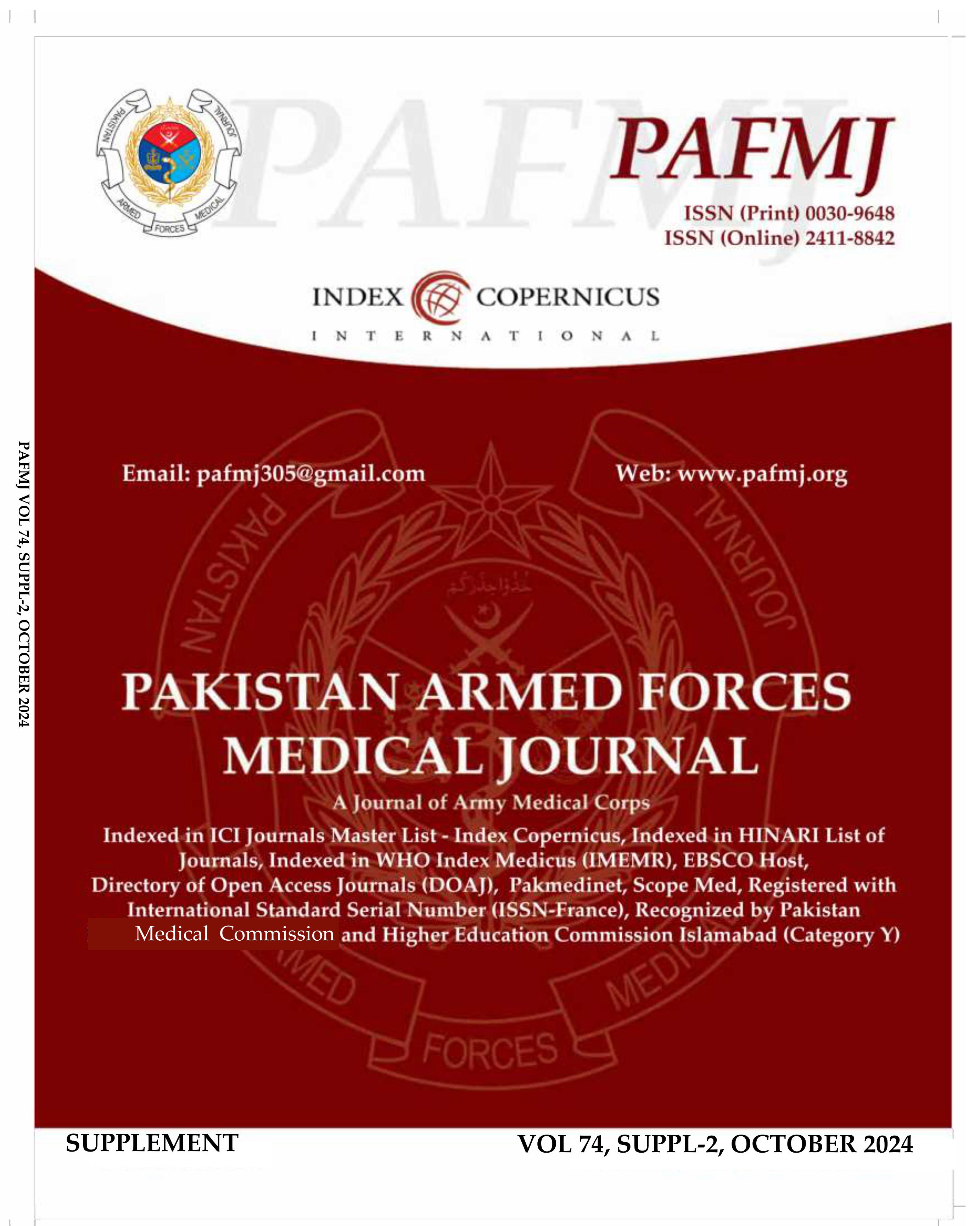Maternal Plasma Lipid Concentration in Early Pregnancy and Risk of Preeclampsia
DOI:
https://doi.org/10.51253/pafmj.v74iSUPPL-2.4610Keywords:
Lipid profile, Preeclampsia, PregnancyAbstract
Objective: To determine the relationship between maternal plasma lipid concentration in early pregnancy and risk of preeclampsia.
Study Design: Cross-sectional study.
Place and Duration of Study: Gynecology and Obstetrics Department Pak Emirates Military Hospital, Rawalpindi Pakistan, Jan 2019 to Jan 2020.
Methodology: A total of 500 pregnant women who came for routine antenatal checkup and underwent serum lipid profile testing at 13th week of pregnancy were included in our study. They were followed up till the end of pregnancy for any signs and symptoms of pre-eclampsia. Age and lipid profile parameters were correlated with the presence of preeclampsia in the study participants.
Results: Out of 500 pregnant women studied, 443(88.6%) had no preeclampsia during the course of pregnancy while 53(11.4%) had preeclampsia. Mean age of participants was 33.72±6.731 years. With binary logistic regression analysis, it was found that raised levels of total cholesterol, triglycerides and low density lipoprotein cholesterol at 13 weeks of pregnancy had statistically significant relationship with presence of preeclampsia later among the target population.
Conclusion: Deranged lipid profile emerged as strong predictor of preeclampsia in our target population. Raised total cholesterol level, triglyceride levels and low density lipoprotein levels were significantly more in patients who developed preeclampsia as compared to those who did not develop this condition.
Downloads
References
Kepley JM, Mohiuddin SS. Physiology, Maternal Changes. [Updated 2019 Apr 24]. In: StatPearls. Treasure Island (FL): StatPearls Publishing; 2020.
Soma-Pillay P, Nelson-Piercy C, Tolppanen H, Mebazaa A. Physiological changes in pregnancy. Cardiovasc J Afr 2016; 27(2): 89–94.
https://doi.org/10.5830/CVJA-2016-021
Catalano PM, Thomas AJ, Huston LP, Fung CM. Effect of maternal metabolism on fetal growth and body composition. Diabetes Care 1998; 21 (Suppl 2): B85-90.
Grimes SB, Wild R. Effect of Pregnancy on Lipid Metabolism and Lipoprotein Levels. In: Feingold KR, Anawalt B, Boyce A, et al., editors. Endotext. South Dartmouth (MA): MDText.com, Inc.; 2000.
Wang J, Li Z, Lin L. Maternal lipid profiles in women with and without gestational diabetes mellitus. Medicine 2019; 98(16): e15320.
https://doi.org/10.1097/MD.0000000000015320
Enquobahrie DA, Williams MA, Butler CL, Frederick IO, Miller RS, Luthy DA. Maternal plasma lipid concentrations in early pregnancy and risk of preeclampsia. Am J Hypertens 2004; 17(7): 574-581.
Spracklen CN, Smith CJ, Saftlas AF, Robinson JG, Ryckman KK. Maternal hyperlipidemia and the risk of preeclampsia: a meta-analysis. Am J Epidemiol 2014; 180(4): 346–358.
https://doi.org/10.1093/aje/kwu145
Jin W, Lin S, Hou R, Chen XY, Han T, Jin Y et al. Associations between maternal lipid profile and pregnancy complications and perinatal outcomes: a population-based study from China. BMC Pregnancy Childbirth 2016; 16(60): 60-69.
Alahakoon TI, Medbury HJ, Williams H, Lee VW. Lipid profiling in maternal and fetal circulations in preeclampsia and fetal growth restriction-a prospective case control observational study. BMC Pregnancy Childbirth 2020; 20(61): 70-78.
Nazli R, Khan MA, Akhtar T,Lutfullah G, Mohammad NS, Ahmad J et al. Abnormal Lipid levels as a risk factor of eclampsia, study conducted in tertiary care Hospitals of Khyber Pakhtunkhwa Province - Pakistan. Pak J Med Sci 2013; 29(6): 1410–1414. https://doi.org/10.12669/pjms.296.3863
Ghodke B, Pusukuru R, Mehta V. Association of Lipid Profile in Pregnancy with Preeclampsia, Gestational Diabetes Mellitus, and Preterm Delivery. Cureus 2017; 9(7): e1420.
https://doi.org/10.7759/cureus.1420
Artha IMJR, Bhargah A, Dharmawan NK, Pande UW, Triyana KA, MahariskiPA et al. High level of individual lipid profile and lipid ratio as a predictive marker of poor glycemic control in type-2 diabetes mellitus. Vasc Health Risk Manag 2019; 15(3): 149–157.
https://doi.org/10.2147/VHRM.S209830
Duhig K, Vandermolen B, Shennan A. Recent advances in the diagnosis and management of pre-eclampsia. F1000Res 2018; 7(1): 242.
https://doi.org/10.12688/f1000research.12249.1
Mayrink J, Souza RT, Feitosa FE,Filho EAR, Leite EF, Vettorazzi J et al. Incidence and risk factors for Preeclampsia in a cohort of healthy nulliparous pregnant women: a nested case-control study. Sci Rep 2019; 9(1): 9517.
https://doi.org/10.1038/s41598-019-46011-3
Aziz R, Mahboob T. Pre-eclampsia and lipid profile. Pak J Med Sci 2007; 23(5): 751-754.
Gohil JT, Patel PK, Gupta P. Estimation of lipid profile in subjects of preeclampsia. J ObstetGynaecol India 2011; 61(4): 399–403.
https://doi.org/10.1007/s13224-011-0057-0
Pusukuru R, Shenoi AS, Kyada PK, Ghodke P, Mehta V, Bhuta K et al. Evaluation of Lipid Profile in Second and Third Trimester of Pregnancy. J ClinDiagn Res 2016; 10(3): QC12–QC16.
https://doi.org/10.7860/JCDR/2016/17598.7436
Enaruna NO, Idemudia JO, Aikoriogie PI. Serum lipid profile and uric acid levels in preeclampsia in University of Benin Teaching Hospital. Niger Med J 2014; 55(5): 423–427.
Downloads
Published
Issue
Section
License
Copyright (c) 2024 Faiqa Chughtai, Humna Syed, Mehwish Ara Shams, Amim Muhammad Akhter

This work is licensed under a Creative Commons Attribution-NonCommercial 4.0 International License.















